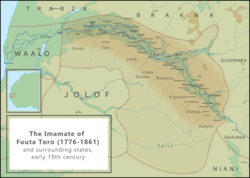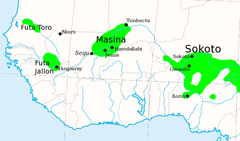Imamate of Futa Toro
Imamate of Futa Toro | |||||||||||
|---|---|---|---|---|---|---|---|---|---|---|---|
| 1776–1859 | |||||||||||
 | |||||||||||
| Capital | Orefonde | ||||||||||
| Common languages | Arabic(official) Pulaar language | ||||||||||
| Religion | Sunni Islam | ||||||||||
| Government | Theocraticmonarchy | ||||||||||
| Almamy | |||||||||||
• 1776–1804 | Abdul Kaader | ||||||||||
• 1875–1891 | Abdul Ba Bakar | ||||||||||
| History | |||||||||||
• Established | 1776 | ||||||||||
• Incorporated into Senegal Colony | 1877 | ||||||||||
• Disestablished | 1859 | ||||||||||
| |||||||||||
| Today part of | Senegal | ||||||||||
| History ofSenegal |
|---|
 |
|
|
TheImamate of Futa Toro(Arabic:إمامة فوتة تورو;Fula:Imaama Futa Toro;French:Imamat de Futa Toro) was aWest Africantheocraticmonarchyof theFula-speakingpeople (FulɓeandToucouleurs) in the middle valley of theSenegal River,in the region known asFuta Toro.[1]Following thetrend of jihadsin the late 17th century and early 18th century, the religious leaderSulayman Balled a jihad in 1776. His successor, the expansionistAbdul Kaderdefeated the emirates ofTrarzaandBraknaand by his death in 1806, power became decentralized between a few elite families ofTorodbes.Threatened by both the expansion of theToucouleur Empireand theFrenchin the mid-19th century, Futa Toro was eventually annexed in 1859. By the 1860s, the power of theAlmamybecame nominal and the state was further weakened when acholeraepidemic killed a quarter of its population in 1868.
Origins
[edit]Futa Toro is a strip of agricultural land along both sides of theSenegal River.[2][a]The people of the region speakPulaar,a dialect of the greaterFula languagesspanning West Africa fromSenegaltoCameroon.They identify themselves by the language, which gives rise to the nameHaalpulaar'en(those who speak Pulaar). TheHaalpulaar'enare also known asToucouleur people,a name derived from the ancient state ofTakrur.From 1495 to 1776, the country was part of theDenanke Kingdom.TheDenianke leaderswere a clan of non-MuslimFulbe who ruled over most of Senegal.[1]
A class of Muslim scholars called theTorodbe[b]seem to have originated inFuta Toro,later spreading throughout the Fulbe territories. Two of the Torodbe clans in Futa Toro claimed to be descended from a seventh-century relative of one of thecompanionsofMuhammadwho was among a group of invaders of Futa Toro. The Torodbe may well have already been a distinct group when the Denianke conquered Futa Toro.[3]
In the last quarter of the 17th century the MauritanianZawāyāreformerNasir al-Dinlaunched ajihadto restore purity of religious observance in the Futa Toro. He gained support from the Torodbe clerical clan against the warriors, but by 1677 the movement had been defeated.[4]After this defeat, some of the Torodbe migrated south toBunduand some continued on to theFuta Jallon.[5]The farmers of Futa Toro continued to suffer from attacks by nomads from Mauritania.[2]By the 18th century there was growing resentment among the largely Muslim lower class at a lack of protection against these attacks.[1]
Jihad
[edit]
In 1726 or 1727Karamokho Alfaled a jihad inFuta Jallonto the south, leading to formation of theAlmamyate of Futa Jallon.This was followed by a jihad in Futa Toro between 1769 and 1776 led bySulayman Bal.[6]In 1776 the Torodbe threw out the ruling Denianke Dynasty.[2]Sulayman died in 1776 and was succeeded byAbdul Kader('Abd al-Qadir), a learned teacher and judge who had studied inCayor.[7]
Abdul Kader became the firstAlmamy[c]of the theocratic Almamyate of Futa Toro.[2]He encouraged construction of mosques, and pursued an aggressive policy towards his neighbors.[7]The Torodbe prohibited the trade in slaves on the river. In 1785 they obtained an agreement from the French to stop trading in Muslim slaves and to pay customs duties to the state. Abdul Kader defeated the emirates ofTrarzaandBraknato the north, but was defeated and captured when he attacked theWolofstates ofCayorandWaaloaround 1797. After his release the jihad impetus had been lost. By the time of Abdul Kader's death in 1806 the state was dominated by a few elite Torodbe families.[2]
Government
[edit]The Almamyate was ruled by an Almamy elected, from a group of eligiblelineages,by an electoral council, which contained a fixed core and a fluctuating periphery of members. Two families were eligible for the throne, the Wane family of Mbumba and the Ly family of Jaaba.[1] Almamys continued to be enthronized in Futa Toro throughout the twentieth century, but by then the role had become ceremonial.[7]
The kingdom was ruled officially by the Almamy, but effective control lay with regional chiefs of the central provinces who possessed considerable land, followers and slaves. The struggle of various coalitions of electors and eligibles further hastened the decline of the Almamyate.[1]In the middle of the 19th century, the Futa Toro was threatened by the French under the leadership of GovernorLouis Faidherbe.[9]The Almamyate at this time was divided into three parts. The Central region contained the seat of the elected Almamy, subject to a council of 18 electors. The west, called the Toro region, was administered by theLam-Toro.The east, called the Futa Damga was theoretically administered by a chief calledEl-Feki,but in practice he had only nominal authority.[10]The Almamyate survived through the 20th century, albeit in a much weaker state.[1]
Collapse
[edit]Omar Saidou Tall,a native of Toro, launched a jihad in 1852. His forces succeeded in establishing several states in theSudan regionto the east of Futa Toro, but the French underLouis Faidherbeprevented him from including Futa Toro into his empire.[2]
To achieve his goals, Omar recruited heavily inSenegambia,especially in his native land. The recruitment process reached its culmination in a massive drive in 1858 and 1859. It had the effect of undermining the power of the Almamy even more.[1]The authority of the regional chiefs, and particularly that of the electors, was compromised much less than that of the Almamy. Some of these leaders became fully independent and fought off the French and Omar Tall on their own. As a result, the Almamy and the chiefs began to rely increasingly on French support.[1]Omar was defeated by the French atMedinein 1857, losing access to Futa Toro.[11]
Futa Toro was annexed by France in 1859, although in practice it had long been within the French sphere of influence.[9]In 1860 Omar concluded a treaty with the French in which he recognized their supremacy in Futa Toro, while he was recognized inKaartaandSégou.[11]In the 1860s the Almamy of Futa Toro was Abdul Boubakar,[d]but his power was nominal.[9]In June 1864 the Moors and the Booseya group of Fula collaborated in plundering trade barges that had become stranded nearSaldéin the east, drawing savage French reprisals against both groups.[9]
In 1868 acholeraepidemic struck the region, killing around a quarter of the population of Futa Toro. The devastation prompted a religious revival led byShaikh Amadu Ba,who threatened the power of the traditional aristocracy. The French supported the authorities in cracking down, and the shaikh'stalibesattacked any French shipping that ventured pastPodor.In 1870 a French expedition pushed Amadu Ba's forces first into central Futa and then into theKingdom of Jolof.[13]
The French generally encouraged strongmen such asAbdul Bokar Kanof Bossea, Ibra Wane of Law and Samba Umahani in Toro when they attacked caravans in the region, since they hoped that it would discourage migration away from the region to Omar's new state.[14]Fear of continuing Muslim migration, however, led the military authorities to attack France's remaining clients in 1890. Abdul Bokar Kan fled but was murdered in August 1891 by the Berbers of Mauritania.[15]The French consolidated their complete control of the region.[1]
See also
[edit]References
[edit]Notes
- ^The word Futa was a general name the Fulbe gave to any area they lived in, while Toro was the actual identity of the region for its inhabitants.
- ^The name "Torodbe" comes from the verbtooraade,meaning to beg for alms in reference to theQur'anic schoolpupils who supported themselves in that way. The label of begging was likely applied by the Denanke court who made fun of the Muslim underclass.[1]
- ^Almamiis derived from the Arabic al-Imam, meaning the one who leads in prayer.[8]
- ^There is some confusion betweenAbdul Bubakarof theImamate of Futa Jallonand Abdul Bubaker of Futa Toro. According to Charles Augustus Ludwig Reichardt, in the introduction to his 1879Fula languagegrammar, the entire country between the upperNiger Riverand theSenegal Riverwas occupied byFula people.He placed the seat of government atTimbo[in Futa Jallon], saying that Futa Jallon had spread towards the Senegal River until it met the Sisibo Fula [in Futa Toro]. They had set up a joint system of government, with two Imams named Omar and Ibrahim, also called kings. Timbo was still the capital.[12]Another source says the two Almamys, in 1876, were absolutely unknown to each other. They were Ibrahim-Sawri in Futa Djallon and Abd-ul-Bubakar in the Senegal Futa [Futa Toro]. The regnal title Almamy was a corruption of "el-Imam" and the governors were subordinate to the Almamy[12]
Citations
- ^abcdefghijOverview of Fuuta Tooro - Jamtan.
- ^abcdefKlein 2005,p. 541-542.
- ^Gomez 2002,p. 36.
- ^Gray 1975,p. 205.
- ^Gray 1975,p. 206.
- ^Stanton et al. 2012,p. 148.
- ^abcLapidus 2002,p. 419.
- ^Hughes & Perfect 2008,p. 4.
- ^abcdMcDougall & Scheele 2012,p. 151.
- ^Grimal de Guiraudon 1887,p. 19.
- ^abLapidus 2002,p. 425.
- ^abGrimal de Guiraudon 1887,p. 19-20.
- ^Charles 1977,pp. 69–70.
- ^Hanson 1996,p. 75.
- ^Fage, J, D. & al.The Cambridge History of Africa,vol. 6, p. 261.Cambridge University Press (Cambridge), 1995 reprinted 2004. Accessed 18 Apr 2014.
Sources
- Charles, Eunice A. (1977).Precolonial Senegal: the Jolof Kingdom, 1800-1890.Brookline, MA: African Studies Center, Boston University.Retrieved15 July2023.
- Gomez, Michael A. (2002-07-04).Pragmatism in the Age of Jihad: The Precolonial State of Bundu.Cambridge University Press.ISBN978-0-521-52847-4.Retrieved2013-02-13.
- Gray, Richard (1975-09-18).The Cambridge History of Africa.Cambridge University Press.ISBN978-0-521-20413-2.Retrieved2013-02-10.
- Grimal de Guiraudon, Th. (1887).Notes de linguistique africaine: les Puls.E. Leroux.Retrieved2013-02-16.
- Hanson, John H. (1996).Migration, Jihad, and Muslim Authority in West Africa: The Futanke Colonies in Karta.Indiana University Press. p. 75.ISBN978-0-253-33088-8.Retrieved2013-02-16.
- Hughes, Arnold; Perfect, David (2008-09-11).Historical Dictionary of The Gambia.Scarecrow Press. p. 4.ISBN978-0-8108-6260-9.Retrieved2013-02-17.
- Klein, Martin A. (2005). "Futa-Tooro: Early Nineteenth Century".Encyclopedia of African History.Vol. 1. Fitzroy Dearborn. p. 541.ISBN978-1-57958-245-6.Retrieved13 February2013.
- Lapidus, Ira M. (2002-08-22).A History of Islamic Societies.Cambridge University Press.ISBN978-0-521-77933-3.Retrieved2013-02-13.
- McDougall, James; Scheele, Judith (2012-06-08).Saharan Frontiers: Space and Mobility in Northwest Africa.Indiana University Press.ISBN978-0-253-00131-3.Retrieved2013-02-16.
- "Overview of Fuuta Tooro".Jamtan.Archived fromthe originalon 23 February 2012.Retrieved2013-02-17.
- Stanton, Andrea L.; Ramsamy, Edward; Seybolt, Peter J.; Elliott, Carolyn M., eds. (2012-01-05).Cultural Sociology of the Middle East, Asia, and Africa: An Encyclopedia.SAGE.ISBN978-1-4129-8176-7.Retrieved2013-02-10.
- Countries in precolonial Africa
- French West Africa
- Kingdoms of Senegal
- Former monarchies of Africa
- Fula history
- 1861 disestablishments in Africa
- States and territories established in 1776
- States and territories disestablished in 1861
- 18th century in Africa
- 19th century in Africa
- 1776 establishments in Africa
- Former theocracies
